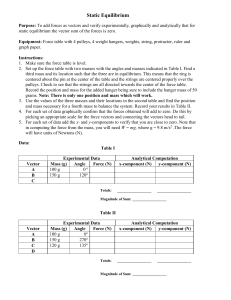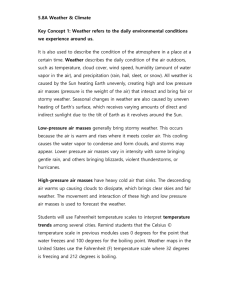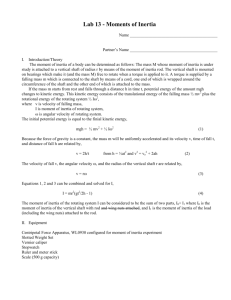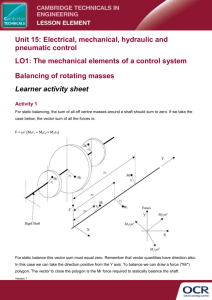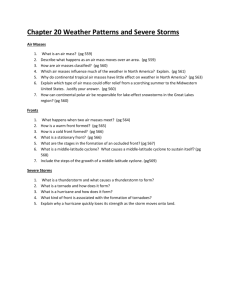Phy221 Lab 3
advertisement
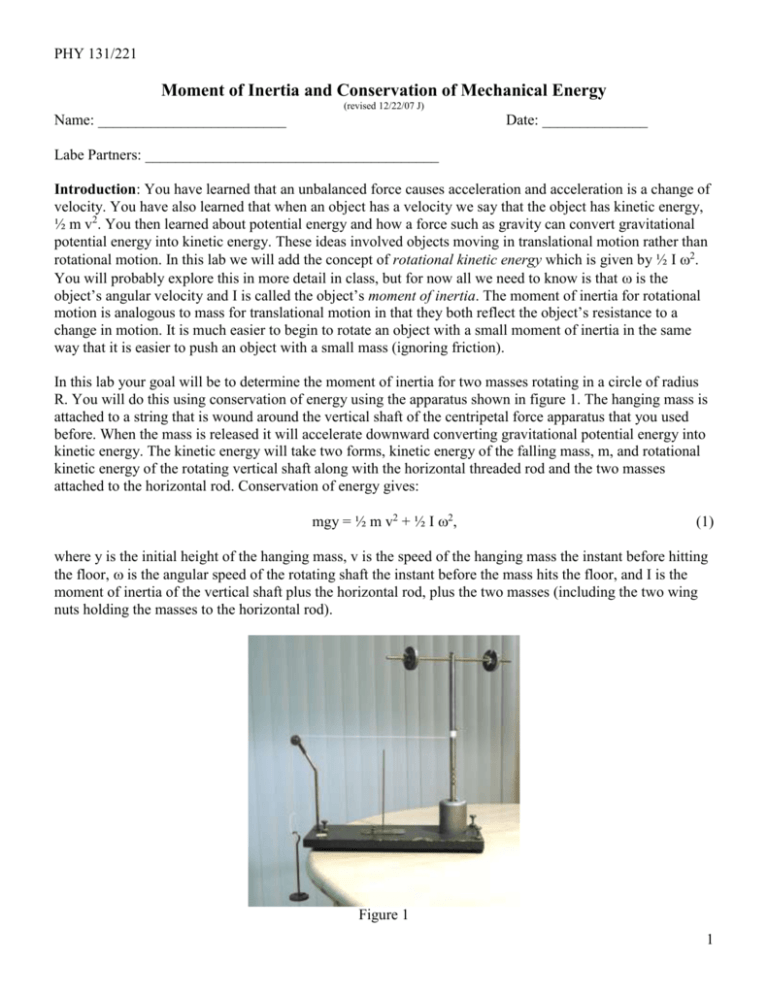
PHY 131/221 Moment of Inertia and Conservation of Mechanical Energy (revised 12/22/07 J) Name: _________________________ Date: ______________ Labe Partners: _______________________________________ Introduction: You have learned that an unbalanced force causes acceleration and acceleration is a change of velocity. You have also learned that when an object has a velocity we say that the object has kinetic energy, ½ m v2. You then learned about potential energy and how a force such as gravity can convert gravitational potential energy into kinetic energy. These ideas involved objects moving in translational motion rather than rotational motion. In this lab we will add the concept of rotational kinetic energy which is given by ½ I 2. You will probably explore this in more detail in class, but for now all we need to know is that is the object’s angular velocity and I is called the object’s moment of inertia. The moment of inertia for rotational motion is analogous to mass for translational motion in that they both reflect the object’s resistance to a change in motion. It is much easier to begin to rotate an object with a small moment of inertia in the same way that it is easier to push an object with a small mass (ignoring friction). In this lab your goal will be to determine the moment of inertia for two masses rotating in a circle of radius R. You will do this using conservation of energy using the apparatus shown in figure 1. The hanging mass is attached to a string that is wound around the vertical shaft of the centripetal force apparatus that you used before. When the mass is released it will accelerate downward converting gravitational potential energy into kinetic energy. The kinetic energy will take two forms, kinetic energy of the falling mass, m, and rotational kinetic energy of the rotating vertical shaft along with the horizontal threaded rod and the two masses attached to the horizontal rod. Conservation of energy gives: mgy = ½ m v2 + ½ I 2, (1) where y is the initial height of the hanging mass, v is the speed of the hanging mass the instant before hitting the floor, is the angular speed of the rotating shaft the instant before the mass hits the floor, and I is the moment of inertia of the vertical shaft plus the horizontal rod, plus the two masses (including the two wing nuts holding the masses to the horizontal rod). Figure 1 1 Your goal is to determine the moment of inertia of just the two masses by themselves. The mass of each of the two masses is designated by M and should include the mass of the two wing nuts. The moment of inertia of just the two masses, I1, plus the moment of inertia of the vertical and horizontal rods, I0, equals the total moment of inertia, I, that we have in equation (1). Using conservation of energy you will solve equation (1) for I and then subtract I0 from this to determine I1. How do you determine I0? You will do the experiment without the masses (and wing nuts) so that the I in equation (1) is equal to I0. You can then directly solve for I0. What measurements do we need to make to solve equation (1) for I? Clearly we need to measure the mass, m, of the hanging weight. But, we also need to measure v and . How do we do this? You should recognize that v and are related. If v is the speed with which the hanging mass is falling at some instant in time, then v is also the speed that the string is moving at that instant. But the string is being wound off of the vertical rod and so the speed that the string is moving is equal to the linear velocity of the surface of the vertical rod. If the vertical rod has a radius, r, then the linear speed of its surface is r, thus v = r. So we only need to determine v in order to solve equation (1). You can determine v by measuring the time, t, it takes for the hanging mass to fall from some fixed initial height, y, to the floor. This is a constant acceleration problem (how do we know?) so we can write that the average velocity equals (vfinal + vinitial)/2, but average velocity is also displacement divided by time, or y/t. And since the initial velocity of the hanging mass is zero we have: vfinal/2 = y/t or v = 2y/t, where we have referred to vfinal simply as v. So for each trial you will measure the height y and the time t. These measurements will allow you to solve equation (1) for I. Part I: Finding I0. For all of your measurements be sure to record the appropriate number of significant digits. Be sure to include as many digits as you can including one estimated digit. Remove any weights and wing nuts from the horizontal threaded rod and be sure the rod is secure. Set the apparatus on the table so that you can hang a weight hanger from the string and it will not hit the table as it is allowed to fall. Be sure the string is long enough so that the weight hanger can actually touch the floor. It is okay to have more than enough string. Measure the mass of the weight hanger and record this as “m” in the first column of table 1. Also, measure the diameter of the vertical shaft to determine its radius. Record this radius just above table 1. Wind the string onto the horizontal shaft so that the bottom of the weight hanger is even with the bottom of the table top. This will be your initial height for every trial during this lab. Measure this height, y, and record it just above table 1. Make three measurements of the time it takes for the weight hanger to hit the floor. If the weight falls very slowly you may add some weight to the hanger, but be sure to change your value of m. Enter these times in the first column of table 1 and calculate the average time. From the time and height calculate the final speeds v and . Use these speeds to determine I, which is equal to I0 in this case. Enter these in table 1. 2 Part II: Constant M with changing R. Now take two 100 g masses and the four wing nuts. Determine the mass of all of these together. Divide this mass by 2 and enter this as the constant mass M in table 1. (The 100 g masses should in fact be 100 g and the wing nuts should all be equal, but weighing all of them and dividing by two helps reduce error since we are assuming that the two masses on each end of the horizontal rod are equal. In other words, if the mass on the left was a little more massive than the mass on the right what would we use for M? We would simply use the average mass.) Use the wing nuts to hold the 100 g masses equal distance from the vertical shaft. Start with a distance R of about 4 cm. Be sure you are measuring from the center of the vertical shaft to the center of the masses. Record your initial distance R in the second column of table 1. Decide on the mass, m, that you will hang from the string and repeat the three time measurements as you did previously. Determine v, , and I, and use your previously determined value of I0 to calculate I1. Repeat the above procedures for R values of about 7 cm, 10 cm and 13 cm. Part III: Constant R with changing M. Now take four 100 g masses and the four wing nuts. Determine the mass of all of these together. Divide this mass by 2 and enter this as the mass M column 6 in table 1. M should be a little over 200 g. Pick a distance R that you used in Part II and enter this as the constant radius R in table 1. The value of R you choose should not be too close to the end, nor too close to the center, of the horizontal rod. Use the wing nuts to hold two 100 g masses a distance R on each side of the vertical shaft. Be sure you are measuring from the center of the vertical shaft to the center of the masses. Decide on the mass, m, that you will hang from the string and repeat the three time measurements as you did previously. Determine v, , and I, and use your previously determined value of I0 to calculate I1. Repeat the above procedures for M values of about 300 g, 400 g and 500 g. Proceed to the Questions section and be sure to include in your lab report a purpose, a discussion of procedures, a conclusion and all necessary plots (properly labeled). 3 Data Radius of vertical shaft, r = ______________(m) M Initial height, y = ______________(m) Constant M = ___________(kg) R Constant R = ____________(m) m (kg) Time to Fall Average Time (s) v (m/s) s-1 I (kg m2) I0 (kg m2) I1 (kg m2) Table 1 4 Questions 1. What was the biggest source of error in this experiment and what reasoning did you use to conclude that it was the biggest? 2. Make a graph of I1 as a function of R (you should have four data points). Does I1 depend linearly on R, or does I1 depend on R2, R3, etc? How do you know? (Hint: Include the point (0,0) in your data since a radius R = 0 should result in a moment of inertia of zero.) 3. If your graph in question 2 was not linear how would you change what you plotted to make the new graph linear? Plot this new graph and determine it’s slope. Is this slope related to the mass M? How? (Again, include the point (0,0).) 5 4. Make a graph of I1 as a function of M with constant R (you should have five data points). Does I1 depend linearly on M, or does I1 depend on M2, M3, etc? How do you know? (Again, include the point (0,0) in your data for a sixth data point.) 5. If your graph in question 4 was not linear how would you change what you plotted to make the new graph linear? Plot this new graph and determine its slope. (If the original graph was linear then determine its slope.) Is this slope related to the distance R? How? 6. Finally, from your analysis, what would an appropriate equation be for I1 as a function of M and R? 6






